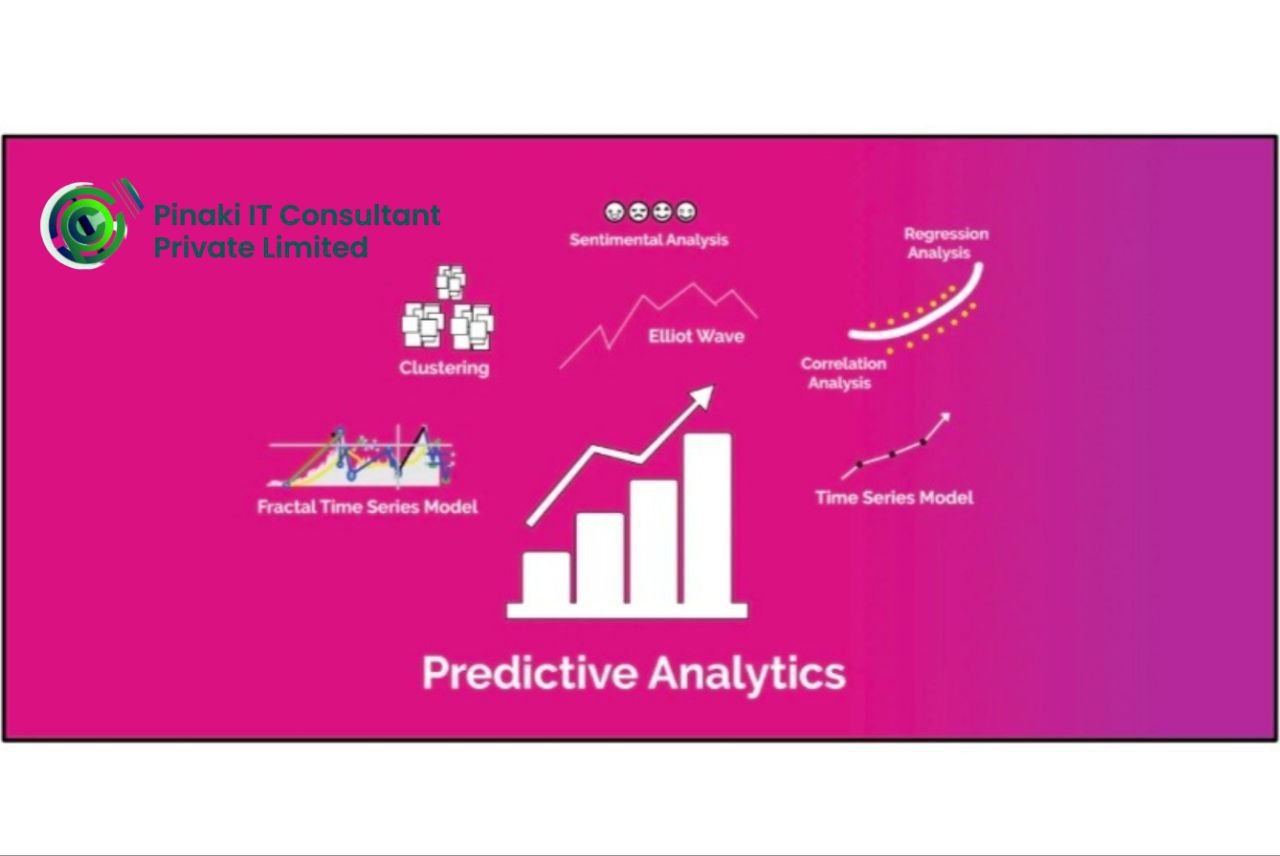
Predictive analytics and predictive AI can help your organization forecast outcomes based on historical data and analytics techniques.
Predictive analytics definition
Predictive analytics is a category of advanced data analytics aimed at making predictions about future outcomes based on historical data and analytics techniques such as statistical modeling, data mining, and machine learning (ML). Many organizations are beginning to leverage redictive AI to speed up automate statistical data analysis. The science of predictive analytics can generate future insights with a significant degree of precision. With the help of sophisticated predictive analytics tools and models, any organization can now use past and current data to reliably forecast trends and behaviors milliseconds, days, or years into the future.
Predictive analytics has captured the support of a wide range of organizations, with a global market size of over $18 billion in 2024, according to Fortune Business Insights. The report projects the market will reach over $95 billion by 2032, growing at a compound annual growth rate (CAGR) of about 23% from 2024 to 2032.

Predictive analytics vs predictive AI
Organizations are increasingly turning to predictive AI over predictive analytics to anticipate, for example, future outcomes, causation, and risk exposure. While predictive analytics frequently makes use of AI tools, it’s driven by humans querying data, identifying trends, and testing assumptions. Predictive AI is autonomous, analyzing thousands of factors and years of data, and can be usd to predict customer churn, supply chain disruptions, and mechanical failures, among other things. ML enables predictive AI to improve its forecasting accuracy over time.
Predictive AI vs Gen AI
Predictive AI forecasts future events and outcomes while gen AI creates novel content. Predictive AI uses a combination of statistical analysis and ML algorithms to uncover insights in
historical data and make predictions about upcoming events, results, or trends and often makes use of smaller, more targeted datasets than gen AI.

Gen AI, on the other hand, responds to prompts or requests by creating content — audio, images, software code, text, video — based on patterns learned from existing content. Gen AI can be used to hold conversations, answer questions, write stories, produce source code, and create images and video. Most start with a deep learning model called a foundation model — often a large language model (LLM) or small language model (SLM) to learn how to generate statistically probable outputs.
Organizations leverage predictive AI for things like financial forecasting, fraud detection, and supply chain management. Gen AI use cases include chatbots and virtual agents for customer service, creating targeted ad and sales copy marketing and advertising, and generating code for software development.
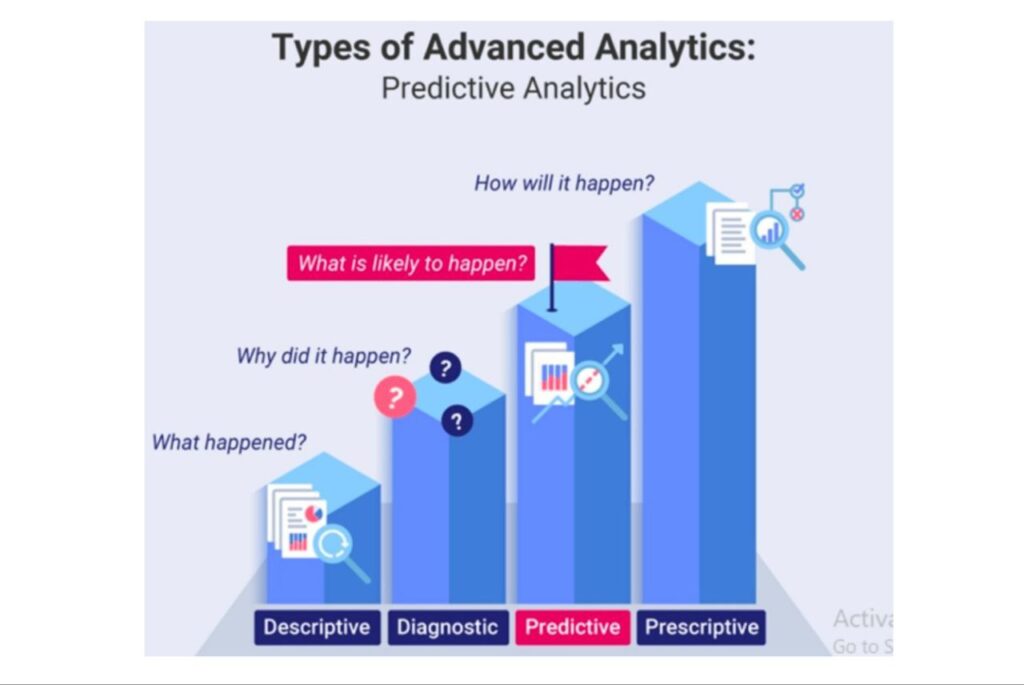
Predictive analytics in business
Predictive analytics draws its power from many methods and technologies, including big data, data mining, statistical modeling, ML, and assorted mathematical processes. Organizations use predictive analytics to sift through current and historical data to detect trends, and forecast events and conditions that should occur at a specific time, based on supplied parameters.
With predictive analytics, organizations can find and exploit patterns contained within data in order to detect risks and opportunities. Models can be designed, for instance, to discover relationships between various behavior factors. Such models enable the assessment of either the promise or risk presented by a particular set of conditions, guiding informed decision making across various categories of supply chain and procurement events. For tips on how to effectively harness the power of predictive analytics.
Benefits of predictive analytics
Predictive analytics makes looking into the future more accurate and reliable than previous tools. As such it can help adopters find ways to save and earn money. Retailers often use predictive models to forecast inventory requirements, manage shipping schedules, and configure store layouts tomaximize sales. Airlines frequently use predictive analytics to set ticket prices reflecting past travel trends. Hotels, restaurants, and other hospitality industry players can use the technology to forecast the number of gests on any given night in order to maximize occupancy and revenue.
By optimizing marketing campaigns with predictive analytics, organizations can also generate new customer responses or purchases, as well as promote cross-sell opportunities. Predictive models can help businesses attract, retain, and nurture their most valued customers.
Predictive analytics can also be used to detect and halt various types of criminal behavior before any serious damage is inflected. By using predictive analytics to study user behaviors and actions, an organization can detect activities that are out of the ordinary, ranging from credit card fraud to corporate spying to cyberattacks.
Challenges of predictive analytics
Initiating and maintaining a predictive analytics practice or predictive AI is no easy task. Here are some of the challenges organizations must account for, according to AI knowledge management specialist, Shelf:
● Data quality and quantity: The quality and quantity of your data are key to the accuracy of predictions. Inadequate or poor quality data will lead to poor results.
● Model complexity and interpretability: Many AI models are complex and opaque. Unless they’re built with transparency in mind, it can be extremely difficult to understand how they arrive at certain predictions.
● Ethical, privacy, and regulatory concerns: Predictive models can have ethical implications, especially around privacy and bias. They must also comply with all relevant regulations. A misstep can lead to a loss of trust.
● Integration and implementation: Integrating predictive analytics into existing systems and workflows requires care and thought, and integrating predictive AI with an IT infrastructure reliant on legacy systems can be difficult.
● Skills gap: Professionals with skills in predictive analytics and predictive AI are in high demand, but they can be difficult to attract and retain.
Predictive analytics use cases
Organizations today use predictive analytics and predictive AI in a virtually endless number of ways. The technology helps adopters in fields as diverse as finance, healthcare, retail, hospitality, pharmaceuticals, automotive, aerospace, and manufacturing.
Here are a few ways organizations make use of predictive analytics:
● Aerospace: Predict the impact of specific maintenance operations on aircraft reliability, fuel use, availability, and uptime.
● Automotive: Incorporate records of component sturdiness and failure into upcoming vehicle manufacturing plans. Study driver behavior to develop better driver assistance technologies and, eventually, autonomous vehicles.
● Energy: Forecast long-term price and demand ratios. Determine the impact of weather events, equipment failure, regulations, and other variables on service costs.
● Financial services: Develop credit risk models. Forecast financial market trends. Predict the impact of new policies, laws, and regulations on businesses and markets. Implement autonomous fraud detection.
● Manufacturing: Predict the location and rate of machine failures. Optimize raw material deliveries based on projected future demands. Use supply chain management to optimize logistics and operations, production plans, resource allocation, and workload scheduling.
● Law enforcement: Use crime trend data to define neighborhoods that may need additional protection at certain times of the year.
● Retail: Follow an online customer in real-time to determine whether providing additional product information or incentives will increase the likelihood of a completed transaction. Project sales and demand for inventory management. Analyze customer behavior data to create personalized recommendations.
Data Science for Fraud Detection
This document provides an introduction to the work of data scientists in the context of using machine learning to fight fraud in digital businesses, including financial services, ecommerce, and social networks. It discusses the main activities, goals, and challenges at play in the intersection of data science and fraud detection with the main purpose of facilitating communication between data scientists and engineers and the other members of fraud prevention teams.
What is the Application of Data Science in Fraud Detection?
Data science is the combination of domain expertise, quantitative methods, and analytical skills to extract meaningful insights from large quantities of information. In the world of fraud detection, data science refers to the activities performed to process the data available for financial services, ecommerce, and other firms to make it as useful as possible to detect and prevent fraud.
The Importance of Data Science for Fraud Detection
You probably already know that machine learning is a game-changer for modern fraud prevention strategies, and we promise that this is not a buzzword. Without the use of artificial intelligence, fraud teams would be outmatched by organized fraudsters that employ expensive and advanced tools to
commit digital crimes. But machine learning algorithms are nothing without sound practices of data science behind them because digital events (purchases, account openings, transactions, etc.) generate more and more data each day, and without the adequate infrastructure to capture data, organize it, and use it in scalable ways, fraud teams can become inundated in “garbage information and internal confusion can bring chaos.
In the context of machine learning, the term data engineering” is often used in a more specific sense to
refer to the construction and transformation of information records (aka data sets) in preparation for
use in an ML model.
Data engineering is crucial to machine learning for several reasons, but these two can very well be the
most relevant:
- GIGO (garbage in, garbage out), a common tenet in computer science, holds that the quality of output is determined by the quality of the input.
- In machine learning, the output is the result of the algorithm, and the input is the data that is fed to it. If the data is garbage, then no matter how sophisticated an algorithm you design, the output will sadly never amount to much more than that too.
- That time equals money might sound like a truism, but data science teams who overlook it can pay dearly.
- According to IBM, in most companies, the so-called 80/20 rule applies because 80 percent of a data scientist’s valuable time is spent simply finding, cleansing, and organizing data, leaving only 20 percent to actually perform analysis.
- WIth the mean salary for a data scientist rising close to $130,000 per year in states like California and New York, we invite you to do the math about all the money that your team invests in data engineering processes.
https://www.ibm.com/industries
https://money.usnews.com/careers/best-jobs/data-scientist/salary
Data Set Construction: The First Step for Fraud Detection
In data science, a feature is a specific property or a characteristic of the process under study. In layman’s terms, a feature is the column of a datasheet that organizes important information.
Constructing a data set typically involves selecting the information that will be used in a machine learning model and integrating it into a single and usable data set. If we compare data engineering to building a house, then this stage would be like choosing the raw materials (bricks, concrete, glass, pipes, etc.) and bringing them into the site for future use.
Let’s start creating our own example. If we were putting together a data set about the transaction history of an online retailer, we would start with something like this:
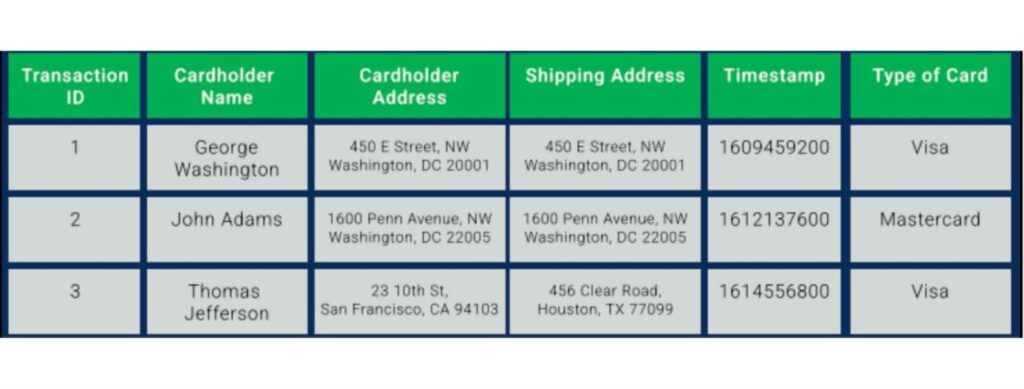
Columns 2 through 6 contain the features of this data set, which are each attributed to transactions identified with an arbitrary ID (column 1). The data set construction process that yielded this table included feature selection activities where a data scientist picked the most relevant attributes out of a larger data set and imported them to create a new table.
It also included data joining activities. There are 6 types of joins: inner, left inner, left outer, right inner, right outer and outer, and in the most common joins, two data sets are combined in a side by side manner to convert them into a single one. For this to work out, both initial data sets need to share at least one column. In other instances data sets are joined by putting one on top of each other, thus requiring all of the columns to be the same.
Data Set Transformation: The Second Step for Fraud Detection-:
Transforming a data set refers to the process of modifying data to make it valuable for the specific purposes at hand. Not all data sets are created equal and, most importantly, no two use cases are identical. It is paramount to transform data into its most usable form to ensure accuracy of the ultimate machine learning application.
The processes of data set transformation are also referred to as feature engineering because logical operations and other functions are applied to features in order to transform the data set with the goal of making it as useful as possible for the specific project at hand.
Feature engineering (a.k.a. feature building or signal creation) is truly part art and part science because
it is the perfect intersection of technical expertise and domain knowledge. Without a thorough understanding of the problems that the algorithm is trying to solve and all the factors that play a part in them, it would be impossible to know what questions to ask the data.
Let’s continue with our example:
Through feature creation, we could derive new information from our data set, potentially garnering a higher predictive power than the raw data.
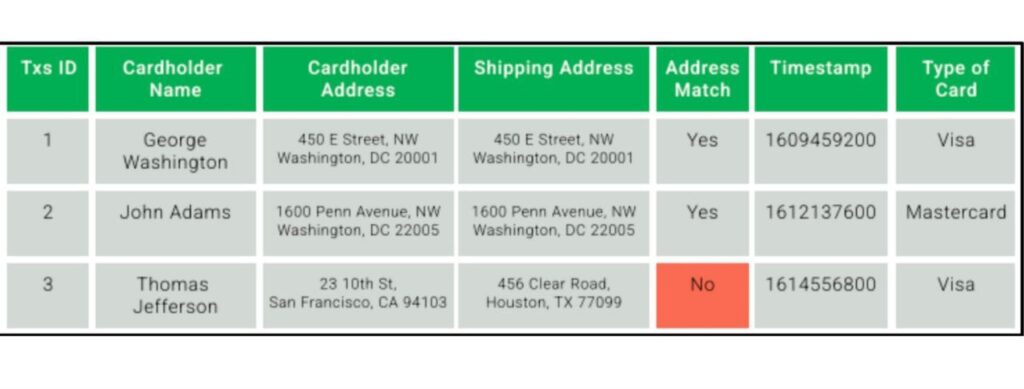
By adding a new feature named Address Match”, our data now tells us whether or not the cardholder
address and the shipping address matches for each transaction, which can be a useful feature for determining if a specific event needs to be reviewed in more detail. Through feature transformations, we could make data easier to understand in human terms and avoid future errors.
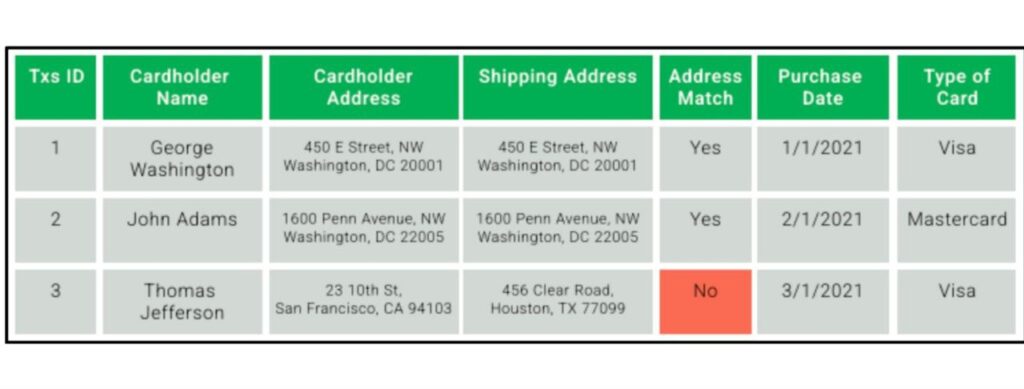
In this case, what we did was use a simple function to convert the timestamp, which was expressed in Unix time (a system for describing a point in time), into a simple date format. We didn t create data, only transformed it.
Through feature extraction, we could automatically create new variables by obtaining them from raw data. This can give us new information in a simplified form or reduce the volume of data for manageability. There are many feature extraction methods such as text analysis, cluster analysis, edge detection algorithms, and principal components analysis. Here’s an example of the first one.
In a much-simplified exercise of feature selection, we could transform our data set to remove certain features that are deemed less important, and focus on the most relevant ones. Perhaps certain features, such as the type of card, can be omitted for specific purposes. Feature selection can also remove redundancies and assign relative weights to different features.

Advanced Feature Engineering Techniques for Machine Learning
Did the simplified examples used above spark your curiosity for the more nuanced activities that data
scientists in your team perform? Great! Mission accomplished. Here are a few more advanced techniques used in feature engineering for ML
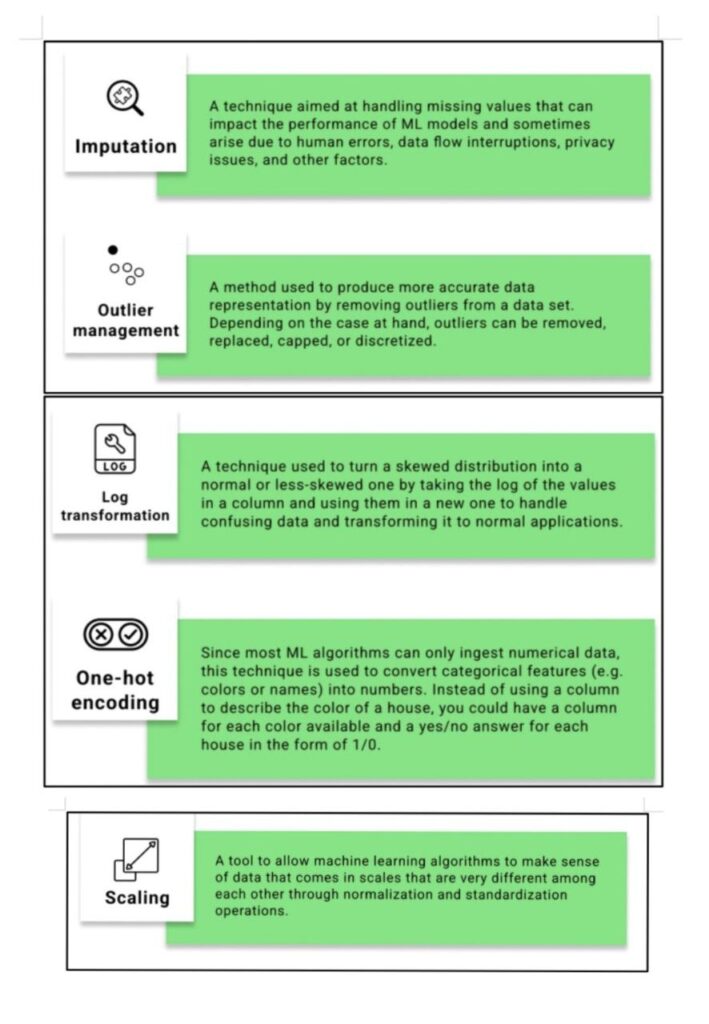
Real-Life Examples Involving Data Engineering-:
Data science teams at Google Maps have in all likelihood invested millions of hours and dollars in ntocreating and transforming the data sets that power their route calculation and live driving direction applications. Can you imagine how much data Google has at its disposal for this? But making sure that the right features and only the right features are fed to models must be a huge task.
Have you ever wondered how facial recognition software, such as the one found in modern Iphones, works? Well, there’s a machine learning algorithm behind it, and behind this algorithm there is a lot of work by data scientists that engineered the database that feeds it. Here’s an in depth explanation of the features it uses and the way these features were engineered.
Main Feature Engineering Needs for Modern Fraud Teams-:
Back to our favorite topic, fraud prevention. We’ve covered why data science is so important for fraud teams and what data scientists actually do when they are performing data engineering. Now it s time to talk about the challenges they face and the tools that they need to be successful in their jobs.
The top three challenges in feature engineering for machine learning fraud prevention are:
- Speed to value. Long development and deployment cycles for new features and models often translate to huge losses before new and emerging fraud patterns are detected and blocked.
- Minimizing IT dependency. Feature engineering processes must be performed without increasing reliance on already saturated resources in information technology departments.
- Agility with data. Being able to bring in new data sources for features and models without interrupting or disrupting their operation is a make-it-or-break it capability in modern fraud
detection strategies.
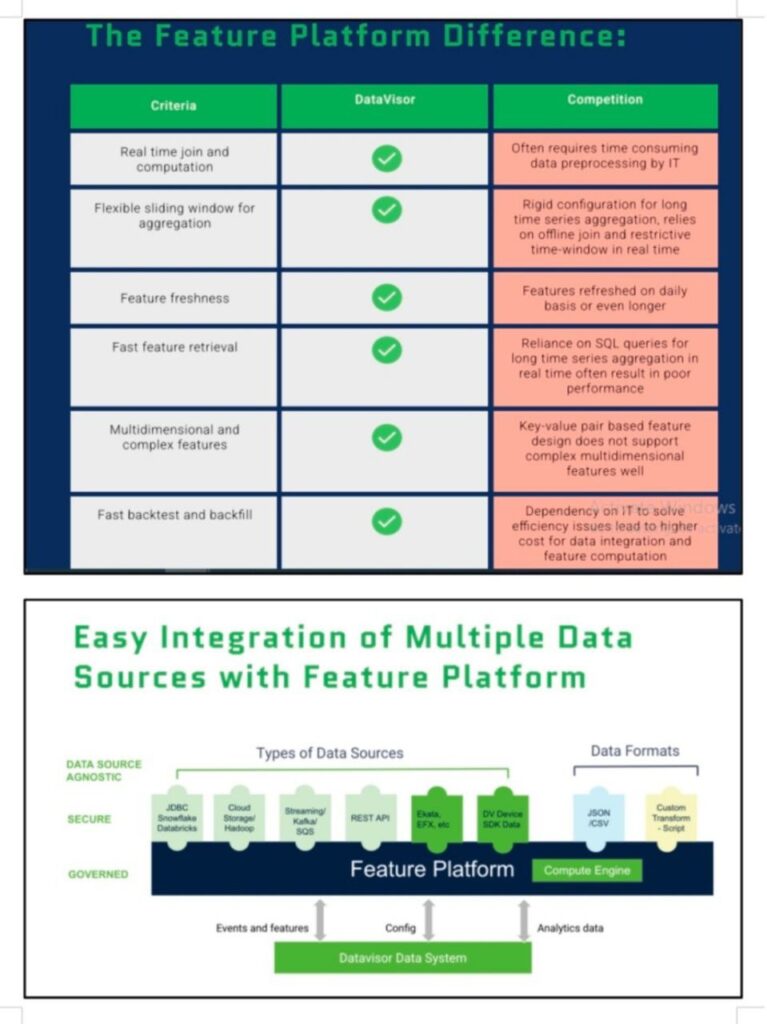


Is data science the key to the future of HR?
In the modern technological era, data plays a crucial role in various aspects of life, including human resource management. Understanding and analyzing data correctly has become essential for companies seeking to improve their performance and attract and retain top talent. Data science plays an important
role in analyzing HR data, guiding strategic decision-making, improving the work environment, and enhancing work efficiency.
As an HR professional deeply involved in the strategic aspects of human resources, I’ve witnessed a significant shift towards data-driven decision-making.
The evolution in our approach is particularly noticeable in areas like talent management, employee engagement, and workforce planning. Utilizing data analytics has not only transformed these areas but also opened new avenues for understanding and engaging our workforce.
Key Findings:
● Data analytics significantly enhances HR decision-making by providing empirical insights into talent management, employee engagement, and workforce planning.
● Organizations using data analytics in HR report improved recruitment outcomes, higher employee satisfaction, and more effective talent retention strategies.
● Challenges include data privacy concerns and the need for specialized skills to interpret complex data sets.
Applications of Data Science in Human Resources:
Employment Data Analysis:
The applications of data science in HR start from recruitment processes, where data analysis can be used to comprehensively examine and analyze recruitment data. Data analysis can identify the best recruitment sources that yield the highest success rates in hiring suitable candidates. Additionally, data science can analyze communication methods with candidates and determine the most effective ways to attract the required talents to the company.
Employee Performance Analysis:
Data science can play a vital role in analyzing employee performance and providing valuable insights into
each employee’s performance. By analyzing performance data, companies can understand the fundamental rules of each employee’s performance, identifying their strengths and areas needing improvement. This information can be used to guide employee evaluations and career development processes, contributing to improving employee performance and developing their skills effectively.
Job Satisfaction Analysis:
Analyzing job satisfaction data can be a valuable tool for companies to understand what makes employees satisfied at work and what can be improved in the work environment. By analyzing satisfaction surveysand feedback from employees, companies can identify the factors that positively and negatively affect employee satisfaction, such as work environment, social relationships, work-life balance, professional development, and more. Based on this data, companies can develop strategies to enhance job satisfaction and increase loyalty to the company, thereby improving employee performance and retaining talented and productive employees.
Health and Safety Analysis:
Analyzing health and safety data can be a valuable tool for companies to improve the work environment and ensure the health and safety of employees. By analyzing accident and injury data, companies can identify the factors that caused accidents and injuries and develop procedures and policies to avoid such incidents in the future. Additionally, analyzing health and safety data can pinpoint areas in the workplace that might pose a health and safety risk and take necessary actions to improve these areas and make them safer for work. By applying data analysis in this field, companies can promote a culture of safety and prevention, ensuring a safe and healthy work environment for all employees.
Employee Engagement and Commitment Analysis:
Analyzing employee engagement and commitment data can be a valuable tool for companies to understand the extent of employees’ alignment with the company’s goals and values and identify the factors that influence their level of commitment. By analyzing data on participation in internal and external events and evaluating employee engagement in teamwork and important initiatives, companies can determine the level of employee engagement with the company’s goals and values. Data analysis can also identify factors influencing commitment levels, such as social relationships at work, career development opportunities, and work-life balance. By using data analysis in this field, companies can enhance employee engagement and commitment to the company’s goals and values, contributing to long-term success and sustainability.
Using data analysis, companies can achieve a qualitative shift in HR management. Better understanding employee needs and aspirations can help companies improve the work environment and provide compensation programs and benefits that better meet those needs. Additionally, guiding strategic decisions more effectively can lead to improved overall company performance, increased employee satisfaction, and loyalty. Data analysis enables companies to make informed, fact-based decisions, helping them thrive and compete in today’s labor market.
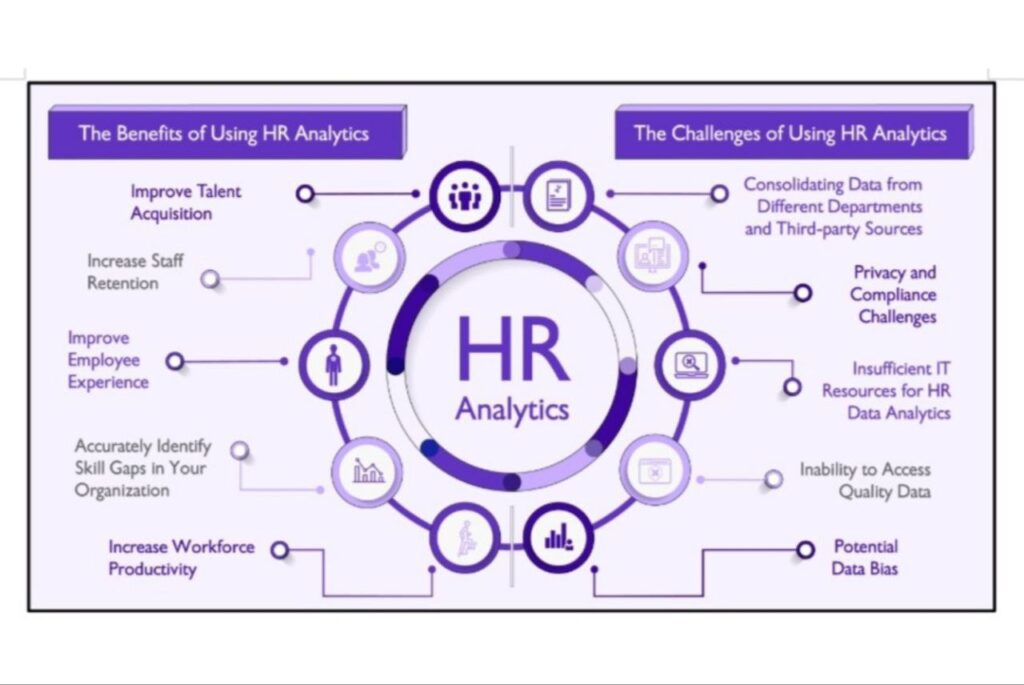
Future of Data Science in Human Resources:
Data analysis is rapidly evolving in various fields, and its vital role in improving HR management stands out. Thanks to data analysis, better understanding employee needs and aspirations and guiding strategic decisions more effectively is now possible. Today, data analysis is not just a means to extract statistics and figures but has become a crucial tool for making informed decisions and achieving sustainable success in the modern work environment.
Artificial Intelligence:
Artificial intelligence (AI) is one of the most important developments in data analysis in HR. Using AI techniques such as machine learning, companies can analyze HR data more accurately and effectively, providing precise strategic guidance for HR management. AI analytics can quickly and accurately analyze resumes, identify key candidate skills, and guide recruitment processes more effectively. These technologies help improve employee selection processes and increase overall HR management efficiency.
Predictive Analytics:
Predictive analytics is an important future aspect of data analysis in HR. Predictive analytics helps companies anticipate future HR needs, identify potential challenges, and take preventive actions more effectively. Using predictive analytics, companies can analyze historical data to identify trends and patterns that may affect future operations. Predictive analytics can also identify areas that need development and improvement and devise strategies to address future challenges more effectively. Thus, predictive analytics contributes to improving HR management strategies and achieving company goals more efficiently.
Human-Machine Collaboration:
The integration between humans and machines is an exciting area of research for the future of data analysis in HR. Combining human strengths in understanding context and making strategic decisions with machine strengths in quickly and accurately analyzing data allows companies to make significant advancements in HR management and achieve strategic goals. For example, big data analysis can provide valuable insights into employee behavior and performance, and intelligent systems can assist in making strategic decisions based on these insights. Thus, human-machine integration can improve decisionmaking processes and achieve sustainability and growth in HR management.
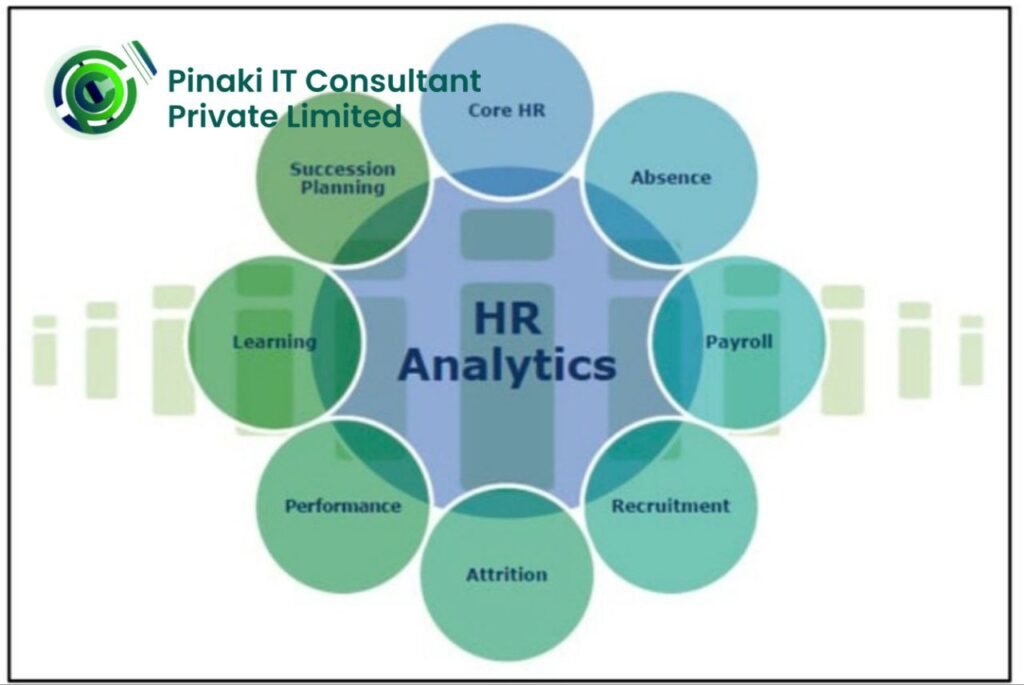
How Does Data Science Help Achieve Sustainability in the Work
Environment?
With the growing importance of HR management in company success and sustainability, data analysis techniques have become a vital tool in achieving HR goals more effectively. Data analysis is an integral part of modern HR management, providing organizations with the ability to better understand employee needs and aspirations and guide strategic decisions based on accurate and reliable evidence. In this context, Doc Suite offers a comprehensive HR management solution, providing powerful analytical tools that help improve employee performance, increase satisfaction, and promote sustainability in the work environment.
Performance and Productivity Analysis:
The Doc Suite HR management system offers analytical capabilities that help companies understand and improve employee performance. Data analysis in Doc Suite can examine employee performance and analyze the reasons behind productivity declines. By analyzing attendance, departure, and performance data, companies can identify factors negatively affecting productivity, such as skill gaps, excessive workloads, or job dissatisfaction. Understanding these factors allows companies to take necessary actions to improve performance and increase productivity, such as providing appropriate training, better work distribution, or enhancing the work environment to boost employee satisfaction and productivity.
Job Satisfaction Analysis:
Job satisfaction data analysis in the Doc Suite HR management system is a powerful tool for companies to understand employee satisfaction levels and improve the work environment based on this feedback. By analyzing satisfaction data, companies can identify areas where employees feel satisfied and areas needing improvement. For example, data analysis may reveal employee dissatisfaction due to a lack of internal communication or insufficient development opportunities. Using this information, companies can take steps to improve these areas, such as organizing internal communication sessions or providing
tailored development and training programs. Analyzing satisfaction data allows companies to enhance employee satisfaction, increase loyalty to the company, and achieve sustainability in the work environment.
Attendance and Departure Management:
Attendance and departure data analysis in the Doc Suite HR management system is an effective tool for companies to understand attendance and absenteeism patterns and take necessary actions to improve these patterns and increase regularity. By analyzing this data, companies can identify factors affecting attendance and departure, such as open vacations, health issues, or personal circumstances. Understanding these factors allows companies to implement encouraging policies and procedures to increase regularity, such as improving reward programs for perfect attendance or providing a flexible work environment to accommodate personal circumstances. Analyzing attendance and departure data allows companies to improve these patterns and increase regularity, contributing to sustainability in the work environment.
Training and Development Analysis:
Training and development data analysis in the HR management system provides companies with the ability to evaluate the effectiveness of training programs and identify areas needing development to achieve sustainable company goals. By analyzing this data, companies can assess the effectiveness of current training programs and determine whether they meet employee needs and company objectives. Training and development data analysis also identifies areas needing improvement, whether by offering new training programs or updating existing ones. Analyzing training and development data allows companies to achieve sustainable goals by improving employee skills and competencies, enhancing their ability to face future challenges.
Employee Engagement and Commitment Analysis:
Employee engagement and commitment data analysis in the Doc Suite HR management system can be
key to understanding employee alignment with company goals and taking necessary actions to enhance
this alignment. By analyzing this data, companies can determine employees’ understanding of company
goals and alignment with them, as well as identify factors that may negatively affect this alignment, such
as lack of communication or transparency in goals. Based on these observations, companies can implement strategies to enhance employee engagement and commitment, such as improving internal communications, providing opportunities for decision-making involvement, or offering incentives andrewards reflecting the importance of commitment to company goals. Analyzing employee engagement and commitment data allows companies to enhance belonging and loyalty to the company, thus achieving sustainability in the work environment.
In conclusion, data analysis is a vital and necessary process in our current era, where companies and
organizations produce vast amounts of data. Proper and effective data analysis can bring significant
advantages to companies, improving performance and making informed strategic decisions. Applications
of data analysis in HR, such as the Doc Suite system, are powerful tools for analyzing employee
performance, understanding their needs, and improving the work environment. Data analysis contributes
to creating a more sustainable and positive work environment where employees work efficiently and
effectively, are more satisfied, and loyal to the company.
Data analysis is not just a technical process but a powerful tool supporting strategic decision-making and achieving success in the modern work environment.
How can HR leverage Data Analytics to drive better decision Making?
Harnessing Data Analytics in HR: A Story of Transformation at Netflix
Imagine a company where every hiring decision is backed by data, leading to stellar business performance. This is the reality Netflix achieved by leveraging data analytics in their HR practices. With an ambitious goal to scale their workforce efficiently, Netflix employs a comprehensive analytical framework that dives into employee performance metrics, retention rates, and hiring patterns. By analyzing these data points, they have been able to increase employee retention by 10% over two years, demonstrating how data-driven decision-making can enhance workforce stability. For HR professionals facing similar challenges, adopting a data-centric approach can offer insights that facilitate judicious hiring choices and optimize team dynamics.
The Case of IBM: Predicting Future Employment Needs Through Advanced Analytics
In another striking example, IBM transformed its workforce management by adopting predictive analytics to address future employment needs. The company was facing the challenge of a skills gap as technology rapidly evolved. By implementing a sophisticated analytical model, IBM could forecast which skills would be in demand over the next several years. This allowed them to tailor training and development programs
accordingly, ensuring their talent pool remained competitive. HR practitioners seeking to navigate the complexities of workforce planning can draw inspiration from IBM’s approach. Utilizing predictive modeling and trend analysis can help organizations stay ahead of impending skill shortages, ensuring they invest in their workforce wisely.
Practical Roadmap: Cultivating a Data-Driven Culture in Your Organization
To translate insights from these compelling case studies into practice, it’s crucial to cultivate a data-driven culture within your HR department. Start by setting clear objectives for data collection and analysis. Incorporating methodologies such as the Balanced Scorecard can help link data analytics to your HR goals, creating a tangible roadmap for your team’s efforts. Additionally, investing in training staff on data
interpretation and encouraging collaborative brainstorming sessions can amplify the impact of your findings. For companies just starting their data journey, it may be beneficial to pilot analytics in one aspect of HR—like recruitment or employee engagement—and use those results to build momentum for a broader implementation, much like how Dell refined their hiring process using applicant tracking systems for enhanced recruitment efficiency. Embracing this transformative shift can lead to more
informed decision-making
1. Understanding the Role of Data Analytics in HR Management
In today’s fast-paced business environment, the utilization of data analytics in human resource (HR) management has transformed the way organizations attract and retain talent. Consider Netflix, which employs sophisticated analytics to optimize not only their hiring processes but also their employee engagement strategies. By analyzing employee performance data alongside their viewing habits, Netflix has crafted a culture that aligns its workforce’s interests with the company’s belief in freedom and
responsibility.
They had the foresight to recognize that data isn’t just numbers—it’s a narrative that tells the story of how people interact within the organization. This underscores a critical takeaway: sure, HR should embrace data analytics, but they must understand the stories behind the data to truly harness its power.
Take a cue from IBM, where the use of predictive analytics has revolutionized their talent management approach. Faced with high turnover rates, IBM implemented a model that predicts which employees are most likely to leave the organization, allowing them to take preemptive measures. They incorporated methodologies like Machine Learning to analyze various factors such as job satisfaction, workload, and employee feedback. The result? A staggering 25% reduction in attrition rates in key roles! For HR teams looking to implement analytics in their processes, it’s essential to start by identifying the core metrics that will have the most significant impact on their workforce.
This could involve simple surveys to gather employee sentiment, which can then feed
into more complex analytics frameworks. However, embarking on a data analytics journey is not without its challenges, as demonstrated by retailers like Target, who initially struggled with data privacy issues
while trying to provide personalized shopping experiences. They smartly redirected their analytics efforts toward employee satisfaction, ensuring customer data did not overshadow employee welfare. For HR practitioners, it’s crucial to balance transparency and ethics while deploying data analytics. Start small—focus on specific HR areas like recruitment or employee retention, and build on your successes.
By fostering a culture where analytics informs decisions yet respects individual privacy, organizations can
create a thriving workplace that leverages data to not just interpret, but to improve the very fabric of their employee experiences.
2. Key Data Metrics Every HR Professional Should Monitor
In the fast-evolving landscape of human resources, understanding key data metrics is essential for informed decision-making. For instance, at Walmart, the retail giant underwent a shift in its hiring strategy by focusing on the cost-per-hire metric. Initially, they found that their recruitment efforts were varied and led to inconsistent quality. By tracking this metric closely, they discovered that reducing cost-per-hire not only improved their budget management but also enhanced the quality of candidates entering their recruitment funnel. For HR professionals, this illustrates the importance of establishing clear metrics monitoring cost-per-hire can directly impact overall hiring efficiency and employee satisfaction.
Another pivotal metric is employee turnover rate, which has significant implications for organizational health. Take Netflix, renowned for its innovative culture. The company rigorously tracks its turnover rate and correlates it with team performance and morale. They discovered that in certain departments, high turnover was a signal of underlying issues, such as poor management practices or misalignment with company values.
This realization prompted targeted interventions and training programs, significantly reducing
turnover. For HR professionals, regularly assessing turnover can reveal essential insights into employee satisfaction and engagement, guiding future recruitment and retention strategies. Lastly, measuring employee engagement through surveys is paramount in ensuring a motivated workforce. Consider the case of Gallup, which utilizes its own Q12 survey—a set of 12 questions designed to gauge employee engagement levels.
The data collected has revealed that organizations with high engagement scores outperform their
competitors in profitability and productivity by up to 21%. HR professionals should adopt such methodologies, regularly employing engagement surveys to identify opportunities for improvement within their teams. By focusing on these critical metrics—cost-per-hire, turnover rates, and employee engagement—HR leaders can develop a robust, datadriven approach to workforce management, ensuring their organizations thrive in a competitive environment.

3. Transforming Employee Experience Through Insightful Data
In today’s competitive landscape, organizations are increasingly recognizing the value of transforming employee experiences through insightful data. Take Unilever, for instance; the consumer goods giant embarked on an ambitious journey to reshape its workplace culture by implementing an advanced data analytics platform. By leveraging employee surveys, performance metrics, and real-time feedback, Unilever managed to increase employee engagement scores by over 15% within a year. This transformation was not merely a superficial upgrade; it involved integrating insights into every decisionmaking process, resulting in enhanced job satisfaction and a remarkable boost in productivity. The real takeaway? When organizations harness the power of data, they can reshape the narrative of employee experience from reactive to proactive.
Similarly, the hospitality sector has seen companies like Marriott International innovate through data-driven employee experience strategies. They deployed a talent management system that actively analyzes engagement levels and training needs, ensuring employees receive personalized learning pathways. As a result, Marriott reported a staggering 20% reduction in employee turnover, showcasing how targeted data insights can drive retention efforts. Such initiatives reinforce the importance of understanding the employee lifecycle, allowing organizations to anticipate issues and address them before they escalate. As best practice, organizations should regularly utilize tools like Net Promoter Scores (NPS) or Employee Net Promoter Scores (eNPS) to gather actionable data that leads to meaningful changes. For organizations seeking to embark on this transformative journey, the implementation of the Agile methodology can be a game-changer. By adopting Agile practices, companies can build cross-functional teams to analyze data continuously and iterate on employee experience initiatives.
A shining example is the tech firm Atlassian, which iterates its employee experience programs based on real-time feedback from its workforce. This agility allows for rapid adjustments and ensures that employees feel their voices are heard and valued. Organizations should consider regular feedback loops and engage employees as collaborators in creating a more fulfilling workplace, as this involvement not only strengthens the bond between management and employees but also enriches the overall organizational culture.
4. Predictive Analytics: Anticipating Workforce Needs and Trends
Predictive analytics has emerged as a powerful tool for organizations seeking to anticipate workforce needs and trends in an increasingly volatile marketplace. Consider the case of IBM, which employs advanced predictive models to assess employee performance and career trajectories. By analyzing data from employee surveys, feedback, and performance metrics, IBM is able to identify potential departures among high-performing employees and implement retention strategies before valuable talent is
lost. In fact, their initiatives have yielded a 30% decrease in attrition rates among critical roles, showcasing how predictive analytics can allow companies to not just react to employee trends but proactively shape them.
However, implementing predictive analytics is not without its challenges. A notable example is the financial services company American Express, which harnessed predictive analytics to optimize its hiring processes. By integrating machine learning algorithms to analyze past hiring data, they could identify characteristics of highperforming employees across various roles. This approach not only streamlined the
hiring process but also led to a 10% improvement in employee performance scores post-hire. For organizations looking to replicate this success, it’s advisable to start small by identifying key performance indicators (KPIs) relevant to your workforce, and gradually scaling your predictive analytics efforts as you refine your models.
For those embarking on their predictive analytics journey, employing the “CRISP-DM” methodology, which stands for Cross-Industry Standard Process for Data Mining, can be highly beneficial. This structured approach involves phases such as business understanding, data understanding, data preparation, modeling, evaluation, and deployment. Take the example of a healthcare provider like Kaiser Permanente, which utilized predictive analytics to forecast patient flow and staffing needs. By employing the CRISP-DM methodology, they improved resource allocation, significantly reducing patient wait times and enhancing service delivery. As you explore predictive analytics, infusing storytelling into your data insights can also enhance engagement, providing a narrative that connects the dots between numbers, employee experience, and ultimately, the success of the organization.

5. The Impact of Data-Driven Decision Making on Talent Acquisition
In a bustling tech hub in San Francisco, the startup Benchling realized that traditional recruitment methods were failing to attract the right talent. They were sifting through resumes blindly, leading to countless hours spent on candidates who weren’t a good fit. To combat this, the company turned to data-driven decision making, implementing a sophisticated applicant tracking system that analyzed past hiring successes and candidate performance. By utilizing key metrics such as employee retention rates and
performance appraisals, Benchling was able to refine their candidate profiles. This transformative approach not only accelerated their hiring process by 30% but also improved employee satisfaction, showcasing the undeniable impact of a data-centric approach in recruitment.
Meanwhile, global consulting firm McKinsey & Company conducted a study that revealed companies that prioritize data-driven hiring practices are 3.5 times more likely to enhance their talent acquisition efforts. McKinsey adopted advanced analytics tools to evaluate potential hires not just based on experience but also on predictive indicators of their future performance within various team structures. They employed structured interviews and psychological assessments to substantiate their findings. This rigorous,
data-backed approach led to significant improvements in team dynamics and overall productivity. The strategy emphasizes the importance of relying on more than gut feeling by utilizing statistical evidence to enhance hiring decisions. For professionals facing similar challenges, it’s crucial to adopt a systematic approach to talent acquisition that incorporates data analytics. Begin by defining your success
metrics clearly—what does success look like for a new hire in your organization? Implement methodologies such as Talent Analytics, which help in identifying and understanding patterns that contribute to high-performing teams.
Utilize hiring software that incorporates AI and machine learning algorithms, ensuring that your recruitment process evolves with changing industry dynamics. Lastly, don’t forget to continuously
collect and analyze data post-hire; feedback loops will allow you to refine your processes further while ensuring alignment between hiring strategies and business goals. Embracing this data-driven paradigm not only results in better hiring outcomes but also fosters a more engaged workforce.
6. Utilizing Data to Enhance Employee Engagement and Retention
In today’s competitive business landscape, employee engagement and retention are pivotal for companies aiming to succeed. Take the case of the tech company Microsoft, which transformed its work culture by utilizing data analytics to evaluate employee satisfaction through pulse surveys. The company discovered that employees were feeling burnt out, leading to a significant turnover risk. By responding to these insights with proactive measures, such as implementing flexible work hours and promoting
mental health days, Microsoft not only saw a 10% increase in employee retention but also fostered a more engaged workforce. The lesson here is clear: harnessing data to listen to your employees can create a more vibrant workplace where everyone thrives.
Another compelling example comes from the retail giant Starbucks, which employs a robust data-driven approach to enhance employee engagement. With their ‘Partner Engagement Surveys,’ Starbucks gathers employee feedback regularly to gauge the workplace atmosphere. By analyzing this data, the company identified that employees desired more opportunities for career advancement and training. Addressing these concerns led Starbucks to implement new development programs and mentorship initiatives, resulting in a 20% improvement in employee satisfaction rates. This approach illustrates the power of using data not just as a tool for assessment, but as a roadmap for strategic change that genuinely invests in employee growth.
For organizations looking to replicate this success, consider adopting a systematic methodology such as the Employee Experience (EX) framework. This involves regularly collecting employee feedback, analyzing it, and creating actionable strategies based on findings. Incorporating tools such as data analytics software or employee engagement platforms can streamline the process. One practical recommendation is to conduct ‘stay interviews,’ where managers ask not just why employees stay, but what could make
their experience even better. By fostering a culture of continuous improvement and dialogue, businesses can create a strong sense of belonging and loyalty, ultimately leading to enhanced retention and a more engaged workforce.
7. Overcoming Challenges in Implementing HR Analytics Solutions
Implementing HR analytics solutions can often feel like navigating through a maze of data, emotions, and expectations. Picture a medium-sized retail company, XYZ Corp, that embarked on this journey only to find themselves overwhelmed by data silos. Their HR team struggled to extract meaningful insights because they relied on disparate systems that spoke different languages. Their goal was to improve employee retention, which hovered around a concerning 50%. Through targeted implementation of an
integrated HR analytics platform, XYZ Corp not only aligned their data sources but utilized predictive analytics to identify patterns in turnover, ultimately reducing attrition by 20%, a feat validated by McKinsey’s research indicating that companies that effectively analyze their workforce can improve retention rates by 25%. To navigate the challenges of implementing HR analytics, organizations should consider adopting a structured methodology, such as Agile HR. Take the case of Acme Corp, a
tech startup that faced resistance from its HR team regarding new analytics tools.
By embracing Agile principles, they implemented iterative cycles where feedback from HR staff and end-users shaped the tool’s development. This approach not only boosted employee buy-in but also ensured that the capabilities aligned with real-world needs. Agile methodologies emphasize collaboration and continuous improvement, fostering a culture where HR practitioners become champions of data-driven decision-making rather than reluctant participants. As Acme Corp embraced this framework, their
employee satisfaction scores increased by 15%, showcasing a clear link between analytics adoption and employee engagement. A vital recommendation for organizations is to invest in comprehensive training and change management initiatives around HR analytics. For instance, in a real-world situation, Global Services Inc. rolled out their HR analytics system without adequately preparing their staff. The result? Usage rates were dismally low, and valuable insights slipped through their fingers like sand.
Learning from this, they restructured their strategy to incorporate regular workshops and hands-on training sessions, quickly transforming their analytics from underutilized tools to integral parts of decision-making processes. By dedicating resources to education and fostering a culture of curiosity,
companies can harness the full potential of analytics, ultimately driving better business outcomes and improving workplace morale.
The role of data science in healthcare advancements: applications, benefits, and future prospects
Abstract
Data science is an interdisciplinary field that extracts knowledge and insights from many structural and unstructured data, using scientific methods, data mining techniques, machinelearning algorithms, and big data. The healthcare industry generates large datasets of useful information on patient demography, treatment plans, results of medical examinations, insurance, etc. The data collected from the Internet of Things (IoT) devices attract the attention of data scientists. Data science provides aid to process, manage, analyze, and assimilate the large quantities of fragmented, structured, and unstructured data created by healthcare systems.
This data requires effective management and analysis to acquire factual results. The process of data
cleansing, data mining, data preparation, and data analysis used in healthcare applications is reviewed and discussed in the article. The article provides an insight into the status and prospects of big data analytics in healthcare, highlights the advantages, describes the frameworks and techniques used, briefs about the challenges faced currently, and discusses viable solutions. Data science and big data analytics can provide practical insights and aid in the decision-making of strategic decisions concerning the health system. It helps build a comprehensive view of patients, consumers, and clinicians. Data-driven decision-making opens up new possibilities to boost healthcare quality.
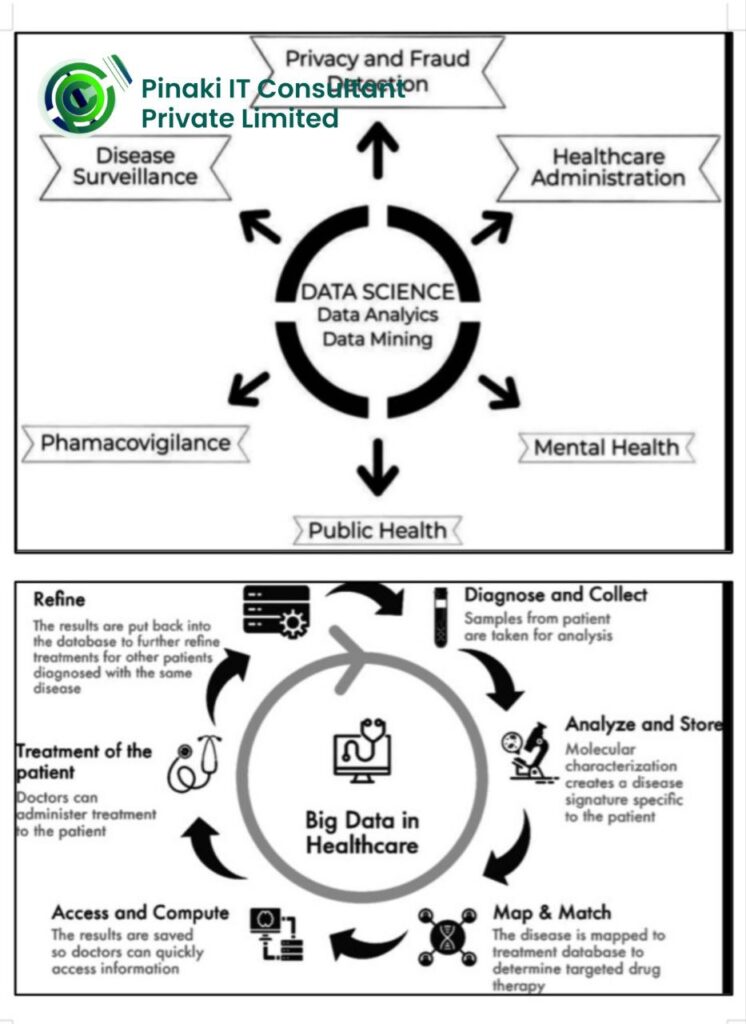
Data Science and Social Media: Unveiling Trends and Influencer Analytics
Social media has become an important part of our lives, as billions of people use platforms like Facebook, Instagram, Twitter, and YouTube. Social media has the power to make anything go viral and enjoyable. For example, if you’re throwing a birthday party with lots of guests, fun activities, and delicious food and drinks, social media can help make your event popular and trending. Additionally, you can even make use of services.
Behind the scenes, data science plays a crucial role in uncovering trends, understanding user behavior, and providing valuable insights for businesses and individuals alike. In this article, we explore the intersection of data science and social media, focusing specifically on unveiling trends and influencer analytics. From analyzing user interactions to identifying viral content, data science enables us to
navigate the dynamic world of social media more effectively.
● Trend Analysis: Data science helps uncover and analyze trends on social media platforms. By collecting and analyzing large volumes of user-generated data, algorithms can identify popular topics, hashtags, and conversations that are trending in real-time. This information is valuable for businesses and marketers to stay up-to-date with the latest trends, tailor their content, and engage with their target audience more effectively.
● Sentiment Analysis: Sentiment analysis is a data science technique that analyzes social media posts, comments, and reviews to determine the sentiment associated with a particular topic, brand, or event. By using natural language processing algorithms, data scientists can classify social media content as positive, negative, or neutral, providing insights into public opinion and brand perception. This information is crucial for companies to monitor their online reputation, address customer concerns, and make data-driven decisions.
● User Behavior and Engagement: Data science helps businesses understand user behavior and engagement patterns on social media platforms. By analyzing metrics such as likes, comments, shares, and click-through rates, data scientists can gain insights into user preferences, content effectiveness, and audience demographics. This information helps optimize social media strategies, create targeted campaigns, and tailor content that resonates with the intended
audience.
● Influencer Analytics: Influencer marketing has become a powerful strategy on social media, and data science plays a key role in identifying and analyzing influencers. Data scientists can evaluate factors such as follower count, engagement rates, audience demographics, and content relevance to determine the impact and effectiveness of influencers. This information helps businesses identify the right influencers for their target market, negotiate partnerships, and measure the success of influencer campaigns.
● Content Recommendation Systems: Social media platforms rely on data science algorithms to provide personalized content recommendations to users. These algorithms analyze user behavior, interests, and interactions to suggest relevant content that aligns with individual preferences. By using machine learning techniques, social media platforms optimize user experiences and keep users engaged by presenting them with content they are likely to find interesting and engaging.
● Viral Content Identification: Data science enables the identification of viral content on social media. By monitoring metrics such as engagement, shares, and reach, algorithms can detect patterns and predict the likelihood of content going viral. This information is valuable for content creators, marketers, and
businesses looking to increase their online visibility and expand their reach. Understanding the elements that contribute to virality can help in creating compelling and shareable content.
● Social Network Analysis: Data science techniques enable social network analysis, which involves mapping and analyzing the relationships between individuals and groups on social media platforms. By examining the connections, interactions, and information flow, data scientists can uncover influential users, communities, and trends within a social network. This analysis helps businesses understand the dynamics of their target audience, identify key influencers, and develop targeted marketing strategies.
● Ad Targeting and Personalization: Data science allows for highly targeted advertising on social media platforms. By analyzing user data, demographics, and interests, algorithms can deliver personalized ads to specific segments of the audience. This level of targeting increases the effectiveness of advertising campaigns maximizes return on investment, and enhances the user experience by presenting relevant ads that align with individual preferences.
● Social Media Fraud Detection: Data science plays a crucial role in detecting and preventing social media fraud. Algorithms analyze patterns of fake accounts, suspicious activities, and bot-generated content to identify and flag potential fraudulent behavior. This helps maintain the integrity of social media platforms, protects users from scams and misinformation, and ensures a safer online environment.
● Social Listening and Brand Monitoring: Data science enables social listening and brand monitoring, where companies can track mentions of their brand, products, or competitors on social media platforms. By analyzing this data, businesses can gain insights into customer sentiment, identify emerging trends,
and make informed decisions about their marketing strategies and product development.
● Crisis Management and Social Media: During times of crisis or emergencies, social media becomes a crucial communication channel. Data science can help analyze social media conversations, identify critical information, and monitor public sentiment during crises. This enables organizations and authorities to
respond promptly, provide accurate information, and manage the situation effectively.
● User Privacy and Security: Data science is instrumental in ensuring user privacy and security on social media platforms. Algorithms analyze user data, behavior patterns, and content to detect potential privacy breaches, unauthorized access, or malicious activities. By implementing data-driven security measures, social media platforms can protect user information, maintain trust, and mitigate potential risks.
● Social Impact Analysis: Data science techniques can be used to assess the social impact of campaigns, events, or movements on social media. By analyzing user-generated content, sentiment, and engagement metrics, data scientists can evaluate the reach, effectiveness, and influence of social initiatives. This information helps organizations measure their social impact and make data-driven decisions for future initiatives.
● Social Media and Crisis Response: During natural disasters or emergencies, social media plays a significant role in disseminating information and coordinating relief efforts. Data science enables the analysis of real-time social media data to identify critical needs, map affected areas, and facilitate efficient
response and resource allocation. This helps organizations, governments, and communities respond effectively and provide timely support.
● Social Media and Political Analysis: Data science techniques can be applied to analyze social media data related to political events, campaigns, and public opinion. By monitoring discussions, sentiment, and user behavior, data scientists can gain insights into political trends, public sentiment toward political candidates, and the impact of social media on elections and policymaking.
Data science is transforming the landscape of social media, enabling businesses, organizations, and individuals to harness the power of data to understand user behavior, identify trends, and make informed decisions. From trend analysis and influencer analytics to user engagement and content recommendation systems, data science provides valuable insights that drive social media strategies and enhance the overall user experience. As social media continues to evolve, data science will play an increasingly vital role in uncovering hidden patterns, improving security, and leveraging the power of social platforms for positive impact.
The Role of Machine Learning in Enhancing Social Media Analytics
Social media is the first place to start marketing your brand and products. The presence of multiple social media platforms allows you to reach a diverse range of audiences.
However, each social media platform generates enormous volumes of data every day. So, you need highly advanced tools and technologies to gather and process the data.
Different technologies and tools are used to collect and analyze data. Machine learning algorithms are used to analyze customer data and draw meaningful conclusions.
Various types of machine learning algorithms are used for different purposes. In this article, I will discuss the role of machine learning in social media analytics. You will also understand the importance of machine learning in marketing.

Understanding Machine Learning in Social Media Analytics-:
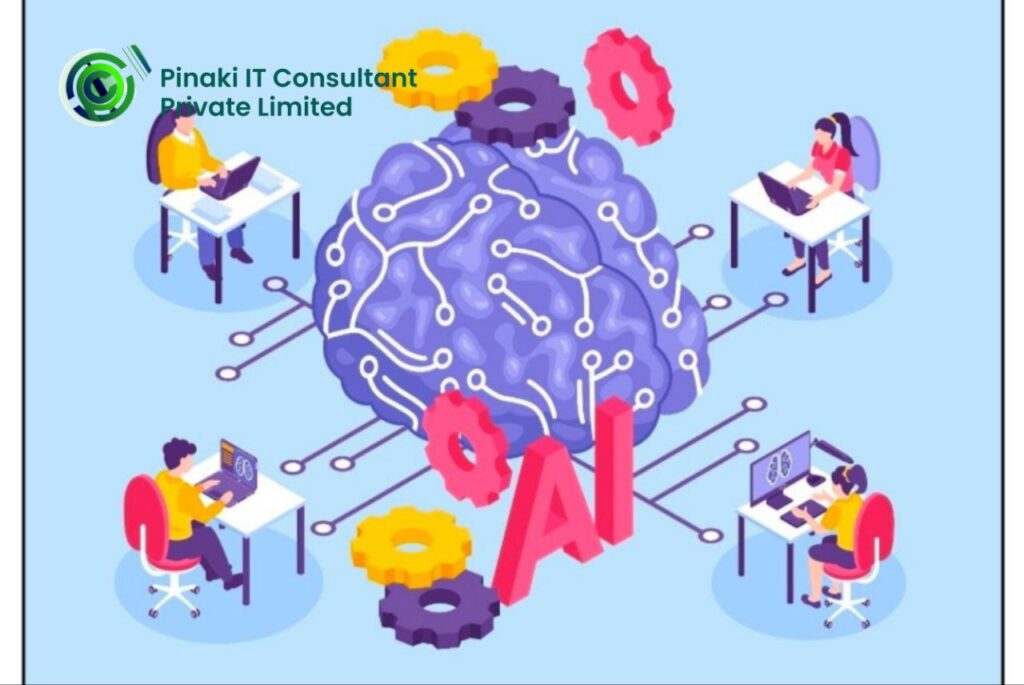
Social media analytics is the process of collecting, analyzing, and interpreting data from different social media platforms. Machine learning is a branch of Artificial Intelligence that mimics how humans think and learn.
The algorithm that is used in machine learning determines its purpose of use. For instance, a machine learning algorithm can be developed to categorize customer conversations as positive or negative. The underlying customer sentiment is analyzed by this algorithm using text analysis and other technologies.
Machine learning algorithms process data, uncover trends, and predict customer behavior independently. So, you can transform your social media analysis by integrating them into your social media accounts and website. These algorithms can also extract insights from data sets and create content.
Social media analytics is all about analyzing customer sentiments and predicting user behavior. Machine learning algorithms are capable of managing these activities with ease. You can respond to negative feedback and reviews in real time by carrying out sentiment analysis through machine learning.
Machine learning is not only capable of analyzing text, but it also comprises image recognition capabilities. Due to this, it can also track conversations that contain your brand logo and products.
Automating Data Collection and Processing
You must collect data to understand customer sentiments, analyze ongoing trends, and track customer reviews. The primary data sources are websites, social media, IoT (Internet of Things) devices, business databases, and physical documents. In machine learning, collecting data is the first step through which you train the ML (Machine Learning) model. You must train the ML model with fresh and relevant data to predict user behavior accurately.
You need machine learning datasets to help the algorithm function smoothly. Many good quality data sets are available for free, i.e., for public use. However, they are basic and might not suit your needs. You can explore the options at Kaggle or CMU to obtain data sets for specific tasks. Once the data is collected, the machine learning algorithms classify it and prepare it for further processing. The data collected from different sources may be unclean or cluttered. So, to make it ready for ML models, you need to clean and format it.
Different methods are used to format the data and find the missing pieces. Once the data is clean and uncluttered, you may use ML algorithms to process and interpret its meaning.
Advanced Sentiment Analysis and Emotion Detection
You can implement machine learning for social media platforms to detect common customer issues and complaints. With these insights, you improve your service or products. Similarly, you can use them to create better content strategies.
The application of machine learning in social media analytics is a bit different. Customer conversations are analyzed to detect customer emotions and sentiments. You might want to understand how your customers feel about your products or services. Or else, you would want to access their perception of your competitors or market in general.
In machine learning, emotion detection is the process of extracting human emotion from contextual data. Advanced NLP (Natural Language Processing), text analysis, and other tools are used to understand customer sentiments.
Different types of methods can be used for emotion detection. Keyword spotting is a method in which certain words are identified to detect the underlying emotions. Learning-based algorithms are used to analyze the sentiments based on previous results. A hybrid approach involves multiple methods like keyword spotting and a learning-based approach.
You can integrate chatbots into your website to perform sentiment analysis through machine learning. You can use text analysis tools to monitor customer feedback and take the required action in real-time.
Predictive Analytics for Trend Forecasting
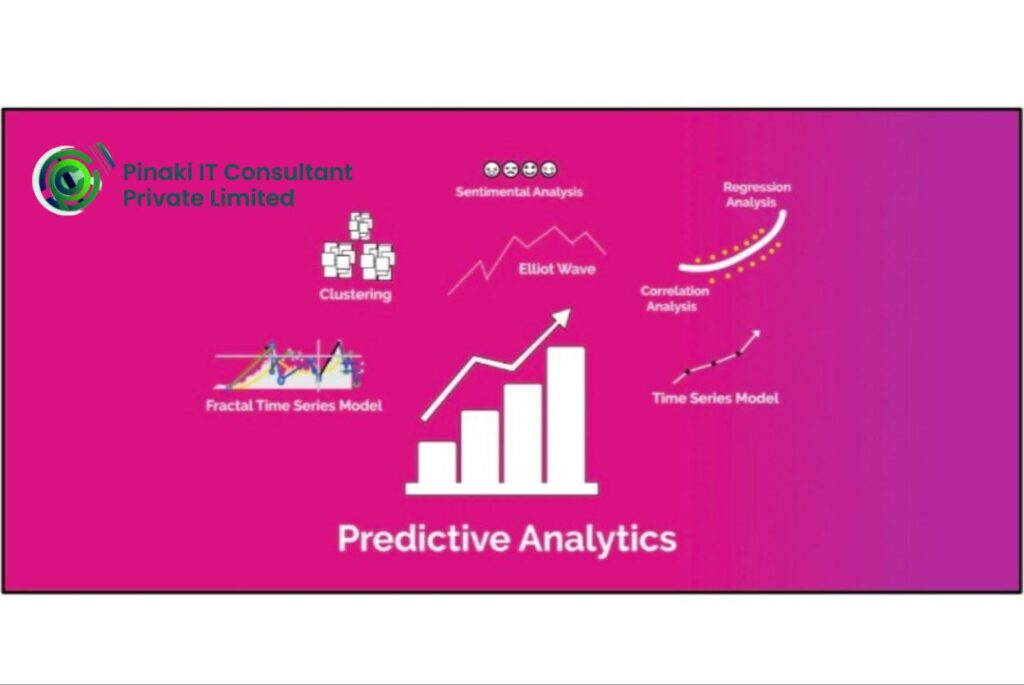
Predictive analytics is a method to predict future events and trends. Both real-time and historical data are used to forecast trends. You need machine learning algorithms and statistical tools to analyze previous data and recognize patterns.
The machine learning use cases in social media analytics usually involve predicting customer
preferences. However, trend forecasting applies to almost all industries. For example, retail companies use demand forecasting to predict future demand for goods. Stock market experts use it to predict the future movement of stock prices. Logistics companies use it for estimating inventory needs. To use predictive analytics for trend forecasting, collect raw data and preprocess it to make it suitable for your research. Depending on the data type and project, you can use different predictive models like random forests, linear regression, decision trees, time series analysis, etc.
Now, the model you select is trained with current and historical data. The models are validated to ensure they work for all general events and unseen data. Finally, the models are used to predict future events and trends. Also, they are updated constantly to make them relevant as per the current market trends and customer behavior.
Personalized Content Recommendations
Personalization is a crucial factor in digital marketing these days. Without personalization, it would be difficult for you to align your marketing objectives with outcomes. Machine learning helps you understand customer needs, preferences, and expectations. By providing insights into their buying behavior and pattern in real-time, it helps you understand their mindset.
At the same time, you can offer them personalized content recommendations based on their browsing history and viewing preferences. For example, if a customer is more interested in watching videos, you can send them a curated list of your product videos. The product videos can be shortlisted based on their buying preferences and interests. Similarly, other content forms, like articles, newsletters, podcasts, etc.,
can be used to create better customer experiences.
For instance, an edu brand like Coursera helps students create a personalized learning path. It allows them to choose quizzes, videos, and other types of learning materials as per their skills and learning goals. Machine learning in digital marketing can also be extended in several other ways. Personalized content recommendations are also useful to build a robust omnichannel strategy. Suppose that a customer visits your website but does not complete the purchase due to slow-loading pages.
You can map the customer journey through different channels to identify their actions and activities. Also, you can identify the customer through machine learning and send them personalized content recommendations. The machine learning algorithm will analyze their previous purchases and profiles before sending the recommendations via email or other channels. This will enable you to make optimum use of your marketing resources.
User Behavior Prediction and Segmentation
User behavior refers to the different activities or processes users engage in before purchasing your products/services. Machine learning unveils these patterns and influences their buying decisions. Suppose that you are a game developer. With machine learning, you can identify how your audience interacts with your game. Also, you can gauge their unexpected behavior, like canceling the subscription or quitting the game.
Analyzing their pain points lets you tweak your game and offer better gaming experiences. Ultimately, it will lead to improved customer retention. The role of machine learning and social media analytics for product development can be understood from the above example. However, the application of machine learning in social media is not limited to it.
Machine learning enables you to adapt your product development and marketing strategies to the changing user behavior. You can always remain ahead of the competition by predicting how user preferences and behavior change. For instance, you can identify the emotional triggers or motivators influencing their buying decisions. By gauging their purchase power, you can recommend the products that fall within their budget. With machine learning, you can predict the marketing channels your customers most engage with.
By optimizing the resources to the preferred channels and by timing the market perfectly, you can maximize your sales and revenue Segmenting users based on their age, gender, interests, and other details can be quite helpful. It enables you to create targeted content strategies for specific segments.
Machine learning and predictive analysis can be employed to determine the type of content that appeals to your specific customers. By using these details, you can develop better ad campaigns and advertisements.
Real-time Insights for Agile Decision-making
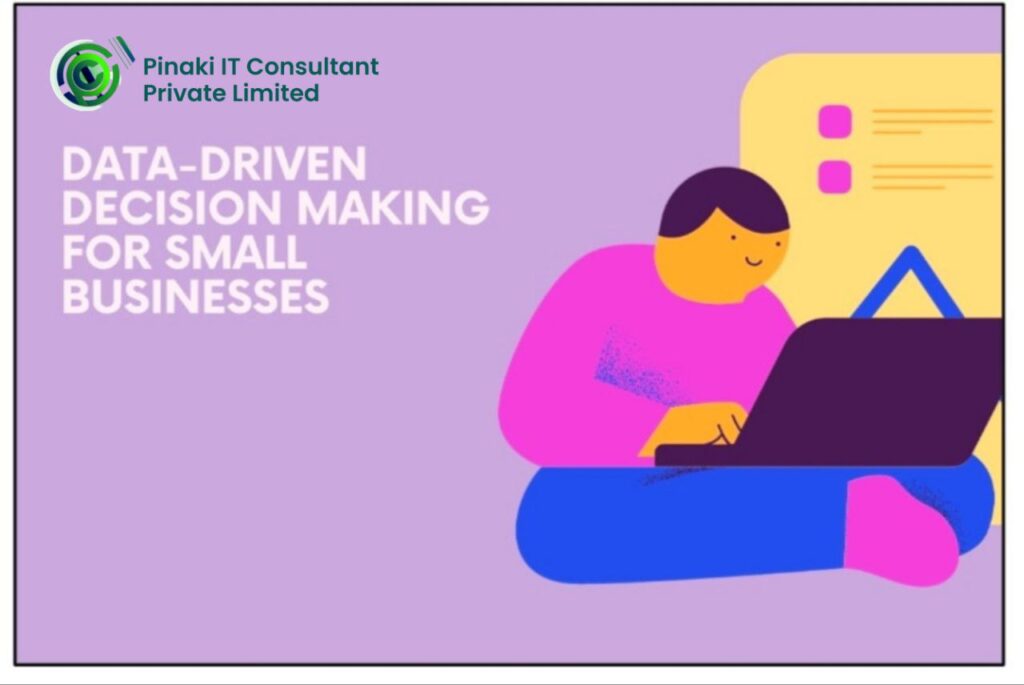
Machine learning provides you with real-time insights into customer behavior and preferences. It also offers insights into the latest trends and opportunities in the market. With real-time insights, you can become agile when reacting to market changes. They let you personalize your offerings and offer better support services. You can tailor your offerings with targeted marketing campaigns to meet customer needs and demands. All of this leads to higher customer satisfaction and improved customer retention.
Agile marketing is a process where you adapt quickly to market changes and evolving customer preferences. Through AI-powered data analysis, you can strengthen your marketing strategies. AI-powered tools mostly comprise machine learning algorithms that analyze huge data sets and interpret their meaning in real-time.
AI-driven marketing platforms are designed to generate content and analyze data automatically.
It allows you to focus on other important strategies and activities. Through predictive analysis, you can forecast market scenarios and future customer preferences. It may unveil opportunities and risks associated with your business in the future. These insights allow you to adapt your decisions and tweak your marketing plans.
Enhancing Fraud Detection and Security
Online frauds are quite common these days. To run your online business efficiently, you must avoid these frauds. With the help of AI and machine learning, you can create robust fraud detection systems. Machine learning models can be trained with historical data involving phishing, online fraud, etc. Machine learning algorithms can alert you by recognizing the patterns involved in these frauds. Also, they can be empowered to change the security protocols dynamically to prevent fraud in the future.
The importance of machine learning can also be incorporated in social media platforms to help them detect spam messages and emails. For instance, decision trees, a machine learning algorithm, can be used to collect content that comes under the spam category. It also prevents spam messages and emails from appearing in users’ inboxes. This ensures the safety of customer data and makes them feel safe on social media apps.
Security systems that use machine learning can offer 24/7 fraud detection. The costs associated with manual tracking and resolution of fraudulent activities can be eliminated. Also, the ability to track huge data volumes in real-time makes it more accurate and efficient than human tracking. While using machine learning to detect fraud has many benefits, you cannot ignore its flaws.
Sometimes, the system can detect a legitimate user as a fraud and block their actions. It may inconvenience the users and result in poor experiences. You can monitor such activities using human intervention and machine learning to mitigate these issues.
Ethical Considerations in Machine Learning for Social Media Analytics
Using machine learning in digital marketing and social media analytics is beneficial. However, you must use them responsibly to avoid violating user rights and government rules. For instance, take the consent of users before feeding their data to machine learning models.
Also, only collect relevant data for your marketing and analysis purposes. Do not store customer data unnecessarily, as it may create security and privacy issues in the future. The data used in machine learning models may contain biases. So, using such models for predicting future events and detecting trends can produce wrong results. So, constantly audit the models to detect their biases and flaws.
While offering personalized recommendations through machine learning, give them the choice to opt out of recommendation services. Also, allow them to set restrictions on their personal and sensitive data. Such actions make your business more trustworthy and reliable.
The Future of Social Media Analytics with Machine Learning
Brands use social listening, machine learning, and AI to offer better customer service. Chatbots and virtual assistants are introduced to provide satisfactory user experiences. However, this is just the tip of the iceberg. Apart from performing sentiment analysis through machine learning, you can also use it to improve customer engagement.
In the future, machine learning and related tools will be the driving forces behind larger brand strategies. For example, AR (Augmented Reality) and VR (Virtual Reality) will be integrated to generate better customer experiences. Integration of these technologies will allow you to offer better customer experiences.
Blockchain technology can be integrated with machine learning to secure customer data. Predictive analytics may have a huge role in creating marketing campaigns and advertisements. Social listening tools are already being used to monitor customer conversations. Machine learning and AI can be used to predict future responses of customers. In the future, these technologies can be blended to direct customer journeys and influence their decisions.
Conclusion
I hope you understand how does social media use machine learning. The scope and applications of machine learning in social media cannot be neglected. However, you must analyze your current marketing needs and concerns before leveraging these technologies. Using platforms that offer better control over consumer data and insights is recommended.
Konnect Insights is an omnichannel customer experience management suite. It includes social listening, social CRM, social publishing, and data analytical capabilities. This platform allows you to analyze customer sentiments and take appropriate actions to maintain your online reputation. Visit Konnect Insights today and take a giant leap towards digital success!



